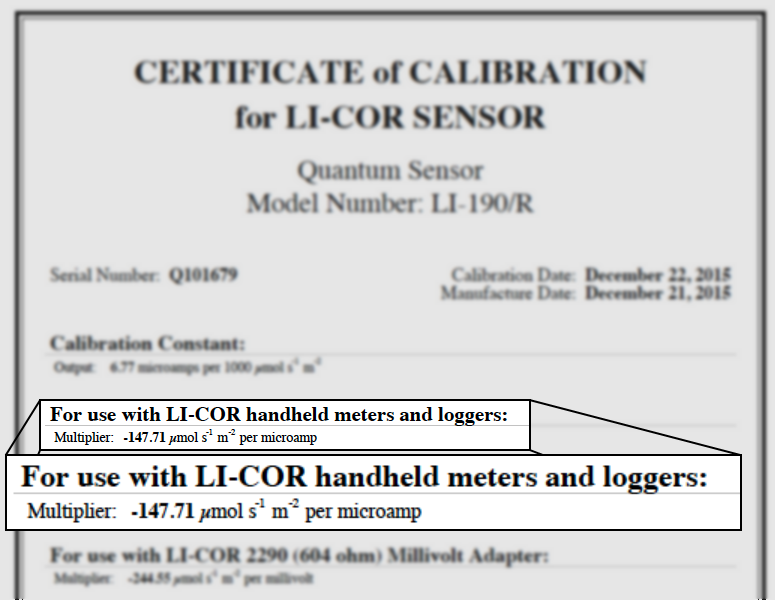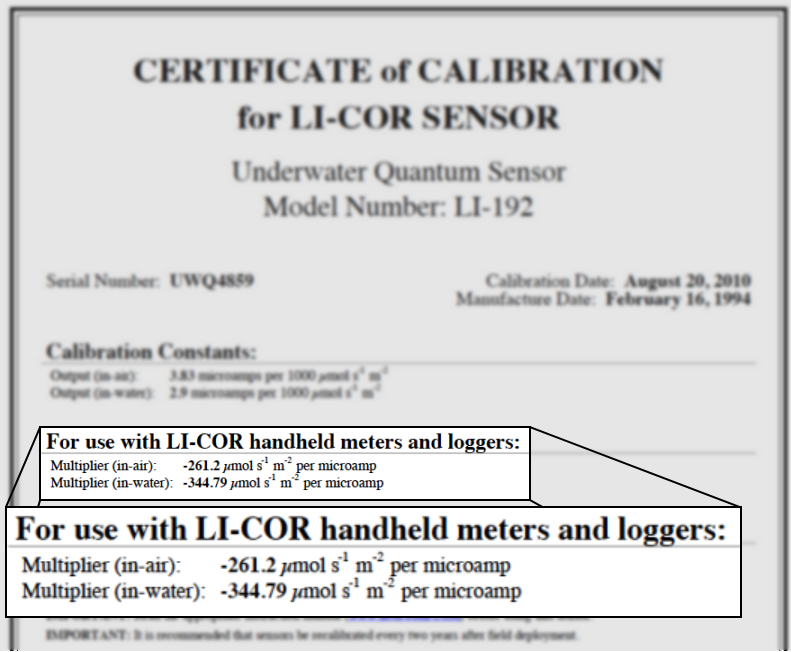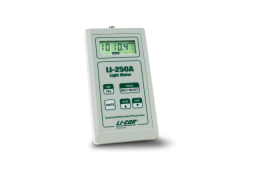Overview of compatible sensors
The LI-250A is compatible with all LI-COR radiation sensors that have a BNC connector (e.g., LI-200R-BNC or older LI-200SA sensors). It is important that the LI-250A be properly configured for the specific sensor used. A quantum sensor measures photosynthetically active radiation (µmol s-1 m-2 of PAR), a pyranometer measures solar radiation (W m-2), and a photometric sensor measures illuminance (lux). It is not possible for a pyranometer to read out in units of lux. If you want the LI-250A to display units of lux, you must use the photometric sensor.
Recalibration of all LI-COR radiation sensors is recommended every two years. The LI-250A does not need to be recalibrated.
Overview of radiation sensor calibration
All LI-COR radiation sensors produce a current proportional to the radiation intensity. During factory calibration, sensor output (in microamps) is measured while the sensor is exposed to a standard lamp of known intensity. The sensor output at this intensity has general units of microamps per radiation unit and is called the Calibration Constant. Each sensor has a slightly different output at a given radiation intensity and will therefore have a unique Calibration Constant. The LI-250A measures the current output of the sensor (microamps) and converts the measured current to units of radiation.
Understanding the certificate of calibration
The Certificate of Calibration (provided with each light sensor, not the LI-250A) includes the model and serial number of the sensor, the date of manufacture, the date of the most recent calibration, and calibration factors that are suitable for a variety of applications. Calibration certificates are available from licor.com/support.
The Calibration Constant is the relationship between a microamp of sensor current output and photons of radiation. The value is labeled Output on the calibration sheet.
The value labeled For use with LI-COR handheld meters and loggers: is the negative reciprocal of the calibration constant (Multiplier = -1 / Calibration Constant). This is the value you will enter in the LI-250A.
Since the Calibration Constant is unique for each sensor, it must be entered into the LI-250A each time the sensor is changed or recalibrated. For the LI-192SA and LI-193SA Underwater Quantum Sensors, there are two calibration multipliers (see Figure 2‑2); one for "in air" operation and one for "in water" operation. Use the multiplier that is appropriate for your application.


Older radiation sensors
For type ‘SA’ sensors manufactured between September 1985 and March 2015, the calibration multiplier is attached to the sensor cable and provided on the certificate. The time coefficient (tcoff) is used to convert integrated data to the proper units when using the LI‑1000 Datalogger to log data with certain sensors. This value can be ignored when using the LI-250A.
Older type 'SB' radiation sensors and new sensors equipped with the millivolt adapter (denoted ‘-SMV’) are also compatible if the Calconnector (Calibration connector) is detached from the BNC connector.
Older type 'SZ' radiation sensors are not compatible with the LI-250A unless they are fitted with a BNC connector. Contact LI-COR for more information.
Calibration certificates for all sensors are available from licor.com/support.
Compatible sensors and accessories
The following accessories and sensors are available for the LI-250A. Contact LI-COR for current information.
- LI-190R-BNC Quantum Sensor: Measures Photosynthetically Active Radiation (PAR) in natural sunlight, under plant canopies, and in growth chambers and greenhouses.
- LI-191R Line Quantum Sensor: Measures average PPFD over its one-meter length for plant canopy PPFD profile studies.
- LI-192SA Underwater Quantum Sensor1: Measures Photosynthetic Photon Flux Density (PPFD) in air or under water incident on a flat plane.
- LI-193SA Spherical Quantum Sensor:1 Measures photon flux from all directions under water. This measurement is called Photosynthetic Photon Flux Fluence Rate (PPFFR).
- LI-200R-BNC Pyranometer: Measures global solar radiation (sun plus sky) and provides a typical accuracy of ±5% under unobstructed daylight conditions.
- LI-210R-BNC Photometric Sensor: Measures visible radiation and has a spectral response equal to that for the average human eye. Readout of illuminance (in lux) is used for lighting studies or architectural modeling.
- 250-01 Carrying Case: A padded case for the LI-250A and terrestrial type radiation sensors. Size: 20.3 cm L × 10.2 cm W × 9 cm D (8" × 4" × 3.5"). Weight: 98 g (0.216 lbs).
- 2003S Mounting and Leveling Fixture: The 2003S is for use with all LI-COR terrestrial type sensors.
- 2222SB Extension Cable: For use with all LI-COR terrestrial type sensors. Available in 15.2 m (50 ft), 30.4 m (100 ft), or custom lengths to 304 m (1000 ft).
- Replacement Battery: 9 Volt Battery. The LI-250A requires a battery for operation.
